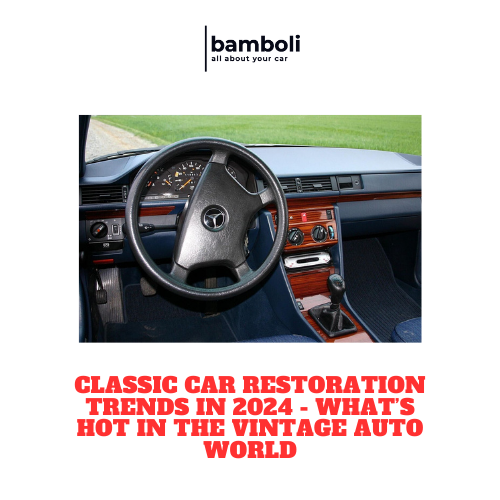Classic Car Restoration Trends in 2024 - What’s Hot in the Vintage Auto World

Classic car enthusiasts and collectors are always on the lookout for the latest trends in vintage auto restoration. As we look ahead to 2024, it's clear that certain styles, features, and models are gaining popularity in the world of classic car restoration. From iconic muscle cars to elegant European imports, there's something for every enthusiast to get excited about. Let's take a closer look at what's hot in the vintage auto world.
Main Points
- Customization: Personalized touches and modifications are becoming increasingly popular in classic car restoration projects.
- Electric Conversions: The trend towards sustainability is influencing the conversion of vintage cars to electric power.
- Retro Styling: Classic cars with retro designs and features are making a comeback in the restoration scene.
- Rarity and Exclusivity: Collectors are seeking out rare and limited-edition models for their restoration projects.
- Modern Technology Integration: Incorporating modern technology into vintage cars is a trend that is gaining momentum.
Reviving Classic Car Colors: A Look Into the Popular Paint Trends
Classic cars, the color of the paint can make a huge difference in the overall appearance and value of the vehicle. In recent years, there has been a trend towards reviving classic car colors that were popular in the past. Let's take a closer look at some of the most popular paint trends that are making a comeback:
- Pastel Shades
Pastel shades such as baby blue, mint green, and blush pink are reminiscent of the 1950s and 1960s era. These soft and subtle colors are making a comeback in the world of classic cars, adding a touch of nostalgia and charm to vintage vehicles.
- Metallic Finishes
Metallic finishes, such as silver, gold, and bronze, are shimmering and eye-catching options that were popular in the 1970s and 1980s. Today, these bold and dazzling colors are being revived, giving classic cars a modern and stylish look.
- Two-Tone Combinations
Two-tone combinations, where two different colors are used on the body of the car, were a popular trend in the 1950s and 1960s. This classic look is timeless and elegant, and is making a comeback as classic car enthusiasts seek to add a touch of retro style to their vehicles.
- Candy Colors
Candy colors, such as cherry red, electric blue, and lime green, were popular in the custom car scene of the 1970s and 1980s. These vibrant and eye-catching colors are now being embraced by classic car owners who want to stand out and make a statement on the road.
- Pastel shades: These soft and subtle colors are perfect for giving vintage vehicles a touch of nostalgia.
- Metallic finishes: Shimmering and bold, metallic finishes add a modern twist to classic cars.
- Two-tone combinations: This timeless and elegant look is a favorite among classic car enthusiasts.
- Candy colors: Vibrant and eye-catching, candy colors are perfect for making a statement on the road.
Performance Upgrades: Enhancing Vintage Cars for Modern Roads
Vintage cars, enthusiasts often face a dilemma between keeping the original look and feel of the vehicle and enhancing its performance for modern roads. While it is important to preserve the authenticity of a classic car, there are certain upgrades that can be made to improve its drivability and overall experience.
Common Performance Upgrades for Vintage Cars:
- Engine Swap:One of the most effective ways to enhance the performance of a vintage car is to swap out the original engine for a more powerful one. This can significantly increase horsepower and torque, making the car more responsive and fun to drive.
- Suspension Upgrades:Upgrading the suspension of a vintage car can greatly improve its handling and ride quality. This can involve installing stiffer springs, shock absorbers, and sway bars to reduce body roll and improve stability.
- Brake Upgrades:Upgrading the brakes of a vintage car is essential for safety and performance. This can involve installing larger brake rotors, calipers, and high-performance brake pads to improve stopping power and reduce brake fade.
Performance Upgrades Table:
|
Upgrade |
Description |
|
Engine Swap |
Replace original engine with a more powerful one. |
|
Suspension Upgrades |
Install stiffer springs, shock absorbers, and sway bars. |
|
Brake Upgrades |
Upgrade to larger brake rotors, calipers, and high-performance brake pads. |
While it is important to respect the heritage of vintage cars, performance upgrades can help enhance their driving experience and make them more enjoyable to drive on modern roads. By carefully choosing the right upgrades and working with experienced professionals, enthusiasts can strike the perfect balance between preserving the past and embracing the future.
Restoration vs. Preservation: Finding the Balance in Classic Car Care
Caring for classic cars, enthusiasts are often faced with the dilemma of restoration versus preservation. Both approaches have their merits, but finding the right balance is crucial to maintaining the authenticity and value of these timeless vehicles.
The Importance of Restoration
Restoration involves bringing a classic car back to its original condition, often requiring extensive repairs and replacements. This process can be costly and time-consuming, but it allows for the car to be enjoyed and appreciated in its full glory. Restoring a classic car can also increase its value, especially if done correctly with attention to detail.
The Significance of Preservation
Preservation, on the other hand, focuses on maintaining the originality and patina of a classic car. This approach involves minimal intervention and aims to showcase the car in its authentic state, with all its imperfections and unique characteristics. While preservation may not always produce a flawless look, it can protect the car's historical significance and charm.
Ultimately, finding the balance between restoration and preservation is key to caring for a classic car. Knowing when to restore or preserve certain parts of the vehicle can help maintain its value while honoring its history. Whether you lean towards restoring or preserving, the most important thing is to care for these automotive treasures with passion and respect.
Emerging Tech in Classic Car Restoration: The Future of Vintage Auto
In recent years, **technology** has been making its way into the world of classic car restoration, revolutionizing the way vintage automobiles are brought back to their former glory. With the development of new tools and techniques, restoring a classic car is now more efficient and precise than ever before.
3 Key Technologies Shaping the Future of Vintage Auto Restoration:
- 3D Printing: 3D printing technology has **transformed** the way replacement parts are produced for classic cars. Instead of searching for rare and expensive original parts, restoration experts can now simply design and 3D print the components they need.
- Virtual Reality: Virtual reality **simulations** allow restorers to visualize the final outcome of their project before even starting the restoration process. This technology helps in planning and executing the restoration with **precision**.
- Augmented Reality: Augmented reality **applications** provide real-time guidance and information during the restoration process. From identifying parts to giving step-by-step instructions, AR has **streamlined** the restoration workflow.
The Future Looks Bright for Classic Car Enthusiasts
With the **integration** of these emerging technologies, classic car restoration is entering a new era. Vintage auto enthusiasts can look forward to faster, more accurate, and more cost-effective restoration projects in the future. The **combination** of traditional craftsmanship with cutting-edge technology is sure to preserve the beauty and history of classic cars for generations to come.
The Art of Interior Restoration: Luxurious Upgrades for Vintage Vehicles
Restoring the interior of a vintage vehicle is a meticulous process that requires a keen eye for detail and a passion for preserving the history and beauty of classic cars. Whether you have a vintage Porsche, a classic Mustang, or a retro Volkswagen Beetle, there are a variety of luxurious upgrades that can take your vehicle to the next level.
- Upholstery
One of the most important aspects of interior restoration is the upholstery. Investing in high-quality leather or custom fabric upholstery can instantly elevate the look and feel of your vintage vehicle. Not only does new upholstery add a sense of luxury, but it also enhances the overall comfort of the driving experience.
- Dashboard and Instrument Panel
The dashboard and instrument panel are key focal points of any vehicle's interior. Upgrading these components with polished wood accents, chrome details, and modern gauges can give your vintage car a modern yet classic look. Incorporating the latest technology, such as digital displays or touchscreens, can also add a touch of sophistication to your vehicle.
- Lighting and Sound System
Enhancing the lighting and sound system in your vintage vehicle can create a truly immersive driving experience. Installing ambient lighting, LED strips, or custom light fixtures can set the mood and highlight the unique features of your car's interior. Similarly, upgrading the sound system with premium speakers, subwoofers, and amplifiers can take your driving experience to the next level.
In conclusion, the art of interior restoration is all about preserving the history and beauty of vintage vehicles while incorporating modern luxury upgrades. By investing in high-quality materials and innovative design elements, you can transform your classic car into a true work of art.
Sustainability in Classic Car Restoration: Eco-Friendly Practices for a Greener Future
Classic car restoration is a beloved hobby for many enthusiasts around the world. However, as we become more aware of the impact of our actions on the environment, it's essential to consider sustainable practices in our restoration projects. By incorporating eco-friendly methods into our work, we can contribute to a greener future for generations to come.
"Sustainability is the key to preserving our planet for future generations." - Unknown
Benefits of Eco-Friendly Classic Car Restoration
There are numerous benefits to adopting eco-friendly practices in classic car restoration. Not only do these methods help reduce our carbon footprint, but they can also lead to cost savings in the long run. By recycling materials, using renewable energy sources, and minimizing waste, we can create a more sustainable approach to preserving vintage automobiles.
Examples of Eco-Friendly Practices
Here are some examples of eco-friendly practices that can be implemented in classic car restoration:
|
Practice |
Description |
|
Recycling |
Reuse and repurpose old parts and materials whenever possible. |
|
Energy-Efficient Lighting |
Use LED or low-energy lighting in your workspace to reduce electricity consumption. |
|
Water-Based Paints |
Opt for water-based paints instead of traditional solvent-based options to minimize harmful emissions. |
By implementing these eco-friendly practices and more, we can ensure that classic car restoration remains a sustainable and environmentally-conscious hobby for years to come.
Frequently Asked Questions
What are the popular classic car models being restored in 2024?
In 2024, popular classic car models being restored include the Ford Mustang, Chevrolet Camaro, Volkswagen Beetle, Porsche 911, and Chevrolet Corvette.
Is it worth restoring a classic car?
Restoring a classic car can be worth it for enthusiasts who appreciate the history and craftsmanship of vintage vehicles. It can also be a rewarding hobby or investment.
How much does it cost to restore a classic car?
The cost of restoring a classic car can vary significantly depending on the make and model, the extent of restoration needed, and the quality of work. It can range from a few thousand dollars to tens of thousands or more.
Where can I find parts for classic car restoration?
Parts for classic car restoration can be found online through specialized vintage auto parts retailers, classic car forums, auctions, salvage yards, and classic car shows.
What are some tips for first-time classic car restorers?
Some tips for first-time classic car restorers include starting with a project within their skill level, doing thorough research, keeping a detailed log of work done, seeking advice from experienced restorers, and having patience throughout the process.




